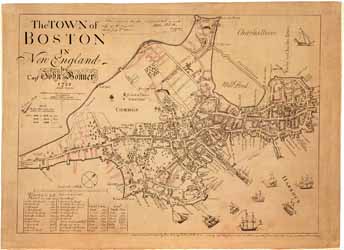The Town of Boston in New England by Capt. John Bonner, 1722. Aetatis Suae 60
To order an image, navigate to the full
display and click "request this image"
on the blue toolbar.
In 1835, George Girdler Smith (1795-1878), an engraver, re-issued the 1722 Bonner map of Boston. The facsimile map, based on the Bonner map in the collections of the Massachusetts Historical Society (the third state of the map probably printed in 1725), includes the following note of authenticity by Stephen P. Fuller, a surveyor, "I have examined this plan and find it to be an exact copy of the original." Another note on the map reads, "Engraved from a copy in the possession of Wm. Taylor Esq."
The 1835 version of the map also includes alterations to the topography of Boston since the first printing of Bonner's map in 1722. These alterations--new streets, buildings, and waterfront developments--appear in red, blue, and green ink. Alterations in red occurred between 1722 and 1733; in blue, between 1734 and 1743; and in green, between 1743 and 1769. The map does not reflect changes made to the Mill Pond area near the North End which the city filled in 1804 with earth taken from Beacon Hill. The map includes an index to points of interest and chronological lists of "Great Fires" and "Genll. small pox."
The facsimile map mistakenly states Bonner's age as 60, rather than 80, as appears on the third state of the map, circa 1725. Please see the online display of the third state of the 1722 Bonner map and look below Bonner's name for the addition of his age, "AEtatis Suae 80."

